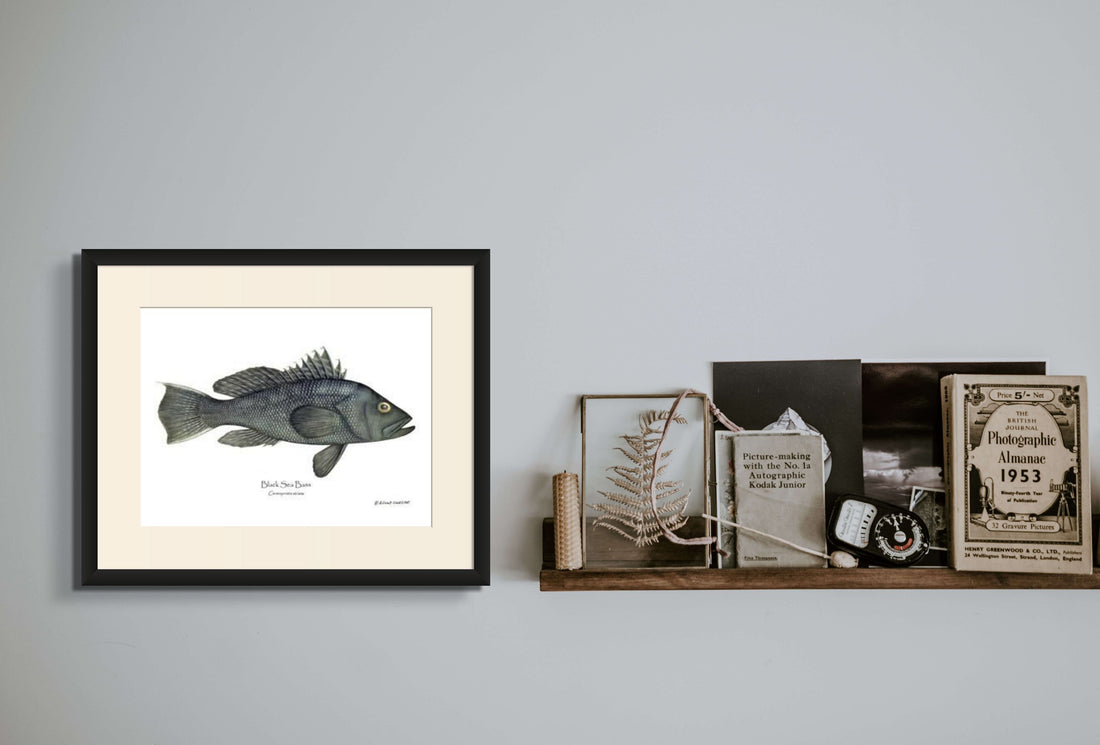
The Black Basses
Share

What’s in a name? A lot if you look under the surface. The American moniker "bass" is a corruption of the German epithet "barsch," meaning perch-like. Well, our North American bass are indeed perch-like, but the 16 fishes on our chart hold little in common besides their name.
You can be certain that after the American Revolution our young country wanted little to do with England. And that included the American academe. But just as France helped us overcome British tyranny, so too did France’s naturalists help us understand our natural world--and that included the black basses. Count Lacépède who authored Histoire Naturelle des Poissons in 1800, was the first to pay any attention to the basses. This early description of the life history of fishes included a description of the largemouth bass as a new species. Lacépède relied on drawings and a narrative of what the fish looked like sent to him from a colleague in South Carolina.
He saw his first real black bass specimen, a mounted smallmouth, in 1802. Unfortunately, the soft dorsal fin of the mounted specimen was torn, giving the appearance of two distinct soft dorsals. He named it Micropterus dolomieu. Micropterus, Latin meaning small fin, referred to the small part of the fin torn away. It’s a misnomer that has stood nearly 200 years and now designates all the black basses. Dolomieu comes in honor of Lacépède’s friend, a geologist and disciple of Izzak Walton. And unbeknownst to Lacépède and Dolomieu, smallmouth bass thrive in streams underlain with dolomitic limestone.
Another native Frenchman, Constantine Rafinesque, an eccentric professor living and teaching in Kentucky is credited with recognizing the spotted bass in 1819. But this rightful recognition would not come but a century later. Like Rafinesque, the spotted bass suffered a recognition crisis. Because of its dark lateral band it resembles the largemouth bass. And to confound the problem, they live in waters similar to what smallmouths prefer. For these reasons, scientists--excepting Rafinesque, of course--and anglers long thought the spotted bass to be a hybrid of its two cousins.
Part of the reason scientists failed to accept the spotted bass as a distinct species is that Dr. James A. Henshall, a Cincinnati physician, insisted in his 1881 Book of the Black Bass, that there were only two black basses. Yet Dr. Henshall struggled with fish identification himself. Of the preserved spotted bass specimens that we know he collected from the Ohio River, some he labeled largemouth, others smallmouth. His notebooks show he dithered back and forth on the proper identification of many spotted bass specimens.
Scientists, Dr. Henshall included, mistakenly believed the specimen Rafinesque used to describe the species was actually a smallmouth bass. Spotted bass remained obscure until 1927, when Michigan ichthyologist, Dr. Carl Hubbs proved to his peers that the spotted bass was indeed a distinct species.
Originally, Dr. Hubbs named it the Kentucky bass, believing that the new species was limited to waters of that state. Our chart shows the two known subspecies of spotted bass, the northern and Alabama forms.
Today there are seven distinct species of black bass. And our chart, Freshwater Bass of North America, has America’s newest sport fish, the shoal bass. This seventh black bass just became known to science late last year--200 years after the largemouth was described. This will probably be the last sport fish species to get a scientific name in North America.
The shoal bass is not necessarily a new discovery. Dr. Hubbs suspected the shoal bass as something different in the late 1930s. Turns out he was right. The shoal bass for years was thought to be a form of redeye bass, a form unique to the Mobile, Apalachicola, and Chattahoochee drainages in Alabama and Georgia.
Habitat requirements of the shoal bass differs from its close cousins by having an absolute requirement for swift-flowing water, or shoals. And therein lies part of a conservation problem. Impounded waters and channelized river sections are hard on this species because they have destroyed shoals. Only seldom do shoal bass occur in flat water. They eat a lot of crayfish and other animals that live in the fast, rocky waters. Without fast water they cannot survive. Their affinity for fast water cannot be over stated.
The Rock Basses Like the black basses, the rock bass and Roanoke bass belong to the sunfish family. They dwell in the clear, rocky-bottom streams throughout the South and Midwest. Pooled up streams are essential to the rock basses. Undercut banks and big boulders are their favorite haunts--places that provide shade where they rely on their large eye to take in lots of light in these shady spots Solitary fish use these dark hiding places to waylay unsuspecting insects, darters, and crawfish. While these species are not major sport fishes, they are important to the angler.
The Sea Basses These fishes need not be confused with the black basses, a wholly freshwater family. The sea basses do, however, have three representatives that naturally occur in freshwater: white perch, white bass, and yellow bass. All members of the sea bass group have a separate spiny and soft dorsal fin. The dorsal fin in the black basses is one continuous fin.
The white perch originally lived in estuaries and streams down the Atlantic seaboard from Nova Scotia through South Carolina. Navigation canals opened the way for them to invade the Great Lakes by the 1940s. Schools of white perch, numbering in the hundreds and even the thousands, leave the lakes and estuaries in spring, ascending rivers and inlet streams to reproduce. If it were not for its brassy coating, the yellow bass could easily be mistaken for a white bass. This schooling fish makes its home in the open, slow-flowing waters of big rivers and oxbow lakes in the Mississippi River basin. It prefers vegetated waters with a firm bottom of sand or rubble and avoids altogether fast-flowing water. Navigation locks and dams may improved the status of yellow bass--they may be more common today than ever before.
Striped bass is the marquee fish among the sea basses. This schooling fish roams over the rocky shores of the Atlantic and Gulf coasts. Between 1879 and 1882, 435 stripers, sent by specialized rail cars from New Jersey, were stocked into California waters. These introductions into the Pacific have been successful. Stripers have been considered a game fish in California since 1935. Their value as a game fish is easily understood knowing they grow to five feet and 60 pounds. As table fare they can’t be beat.
Note: The chart used in this factoid, Freshwater Bass of North America, can be purchased by Clicking Here
Craig Springer, Outdoor Writer Post Office Box 535 Edgewood, N. Mex. 87015
